| 1 | Victoria’s main venomous snake |
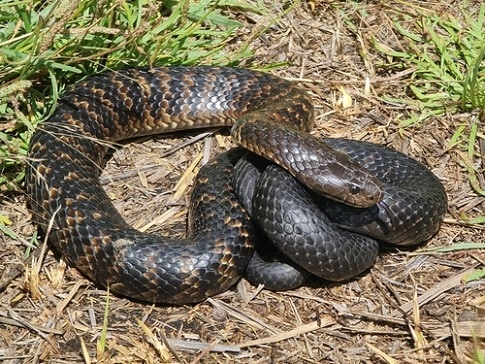
Australia has at least 10 snake species capable of ending your life, some found in dry apocalyptic wastelands and others in comfortable city suburbs. The most common venomous species in southern Australia is the tiger snake (Nochesis scutatus), which averages at 120cm, with rare brutes reaching 2 metres.
Like an eastern brown snake, tiger snakes are found near Sydney, though less commonly in suburbs and streets. Their real heartlands are milder southerly areas like Victoria and Tasmania, as well as Western Australia near Fremantle. You won’t find tiger snakes alongside freshwater crocodiles, but potentially kangaroos, and 150 years ago, you might have found one by a bandit (Ned Kelly’s) campfire.
Tiger snakes have flexible habitats, with the only requirement being moisture. They never appear in dusty outbacks, preferring a mixture of forest, marshland, and open grassy fields. You can find one crossing a wide road surrounded by fields. You can find one on a rocky outcrop proudly surveying its small, sequestered corner of a forest. You can find one bobbing along in a marsh, or disappearing down a bushy hillside from a hiking trail, with its tail the last thing to disappear. However, one study did find that adult tiger snakes stuck to habitats they were raised in, such as aquatic environments like marshes, or terrestrial environments like forests. Compared to eastern browns, tiger snakes are more common near water overall.
| 2 | Not a tiger, but just as deadly |
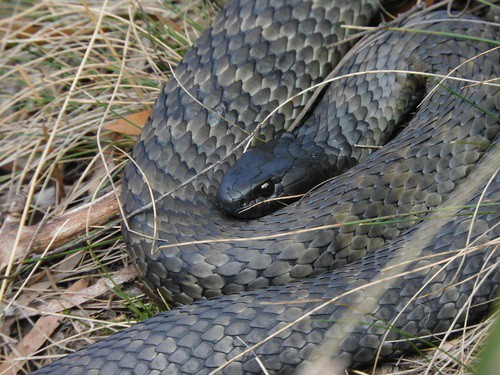
If you see a tiger snake, you shouldn’t run for your life, but nor should you get closer. The statistics are ominous, as from 2005 to 2015, tiger snakes caused 17% of all venomous Australian snakebites, compared to 41% for the brown snake family, and 16% for red-bellied black snakes. This included 4 deaths, and the most recent death took place in 2020, to a 78 year old man in Tasmania.
Fortunately, humans are low on the tiger snake’s list of concerns. They have much more pressing matters to deal with – emerald spotted treefrogs to eat, goshawks to dodge, and ensuring that a pond is nearby so that they can vanish into it if necessary. Like most snakes, you’ll survive a tiger snake encounter as long as you don’t get in their face, or pick them up while drunk.
Tiger snake deaths are far less common than they used to be, mainly due to antivenom. The oldest recorded death involved police inspector William Drummond in 1857, who watched on sceptically while a daredevil called Shires allowed himself to be bitten before a cheering crowd. Drummond demanded to be bitten by the tiger snake as well, believing Shires to be a fraud. However, he fell unconscious and died, and Shires was found not guilty of manslaughter, as he wasn’t permitted to administer his special, homemade antivenom brew.
| 3 | Neurotoxic, myotoxic, and haemotoxic |
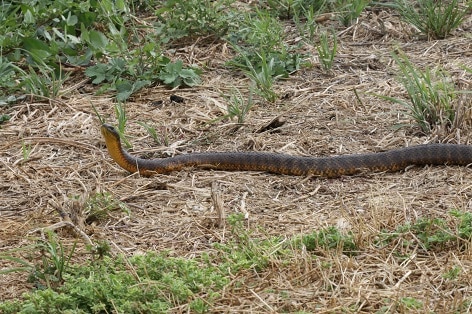
In 2012, a study gave everyone what they wanted, and performed a full breakdown of tiger snake venom symptoms. Searching detailed hospital records, they used data on 60 confirmed tiger snake bites, eliminating any with a slight chance of misidentification. This included 56 envenomations and 4 dry bites (which happens occasionally). Most bites occurred in southern Australia, and 9 were inflicted by captive tiger snakes.
Firstly, not one death occurred in the study. Overwhelmingly the most common symptom was venom-induced consumption coagulopathy (VICC), which affected 53 out of 56 patients, 14 with partial VICC and 39 with complete VICC. This is a relatively common symptom in snakes, particularly vipers. VICCs accelerate the activation of blood clotting factors, such as the conversion of fibrinogen to fibrin, via increasing the mediator thrombin, to form multiple small clots in the bloodstream which serve no purpose. This depletes the supplies available to clot actual wounds.
These are procoagulants, the reverse of anticoagulants, which directly cleave through fibrinogen, but with a similar end result. Spontaneous bleeding was observed in 17 of 56 patients, including 2 patients from the gums.
| 4 | Expect nausea, headaches, vomiting |
Neurotoxic symptoms were also common, though not guaranteed, at 30% (17) of patients. The worst affected patient suffered limb weakness, and required artificial ventilation and intubation after suffering laboured breathing.
11 patients experienced myotoxicity, damage to muscle tissue, as evidenced by increased creatine kinase, the classic bloodstream biomarker for muscle destruction. 5 additional patients had creatine kinase rises, suggesting more minor muscle damage. As you’d expect, all 11 patients developed muscle pain and tenderness. At its worst, myotoxicity can progress to kidney failure, but none of the patients reached that level.
As for local symptoms, swelling affected 33 out of 56 patients, and pain 51. Only 2 patients developed rotting, necrotic flesh, so necrosis seems to be a rare base that tiger snakes don’t cover.
Other extremely common symptoms include nausea (44/56 patients), headache (34), and vomiting (35). Abdominal pain affected 15, and excessive sweating affected 24.
While capable of savage bursts, tiger snakes are less twitchy and nervous than an eastern brown snake. It’s like they understand that they have 200mg of lethal notexins and procoagulants sitting in their venom glands, and are confident because of this. See this video where a guy held his face just feet from one for 5 minutes with no strike.
| 5 | Performs a cobra neck flare |
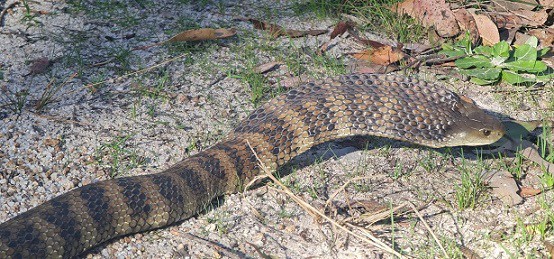
Tiger snakes can hold their breath for 20 minutes underwater, and will sometimes flee into marshes or lakes to escape predators. A September 2019 study from Herdsman Lake watched one hide underwater for 18 minutes, 36 seconds before surfacing to take a breath. Tiger snakes are adept at swimming underwater, although they’ll also hide in dense vegetation on the shore. This is a species you could see on the opposite side of a river staring at you menacingly.
Many tiger snakes are vivid black and yellow, with a yellow belly and black back. Some have a light grey, almost white belly, and a dark grey back. As the tiger name suggests, most have faint stripes, which aren’t thin, but blend in with the main colours gradually, rather than contrasting vividly. These stripes match the belly colour: either yellow, light grey, or olive.
Tiger snakes also share a skill of the cobra family, their distant elapid cousins: flattening their neck, to create a false illusion of size. They do this when in attack formation, for intimidation, and while not as wide as monocled cobras, it’s still impressive. An intimidation skill they lack is a brightly coloured mouth. Unlike a cottonmouth (snowy white), or a black mamba (velvety black), the tiger snake’s mouth is a simple fleshy pink. Their tongue is oily black.
| 6 | Grips amphibians, releases mammals |
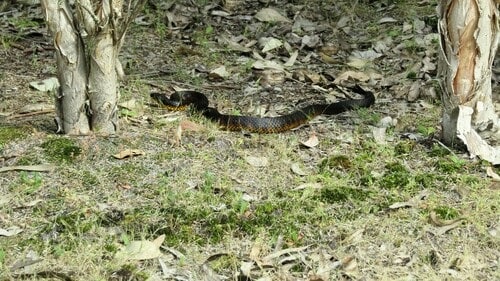
Tiger snakes are intelligent and vary their tactics by prey. Tiger snakes bite and release rodents instantly, but with amphibians, they normally cling on, maintaining their fang-hold until they succumb. With rodents, they typically waited for 5 minutes, before following a scent trail to the dying prey.
50 tiger snakes were observed in captivity, with hundreds of feeding events on mammals – every last one used this “strike and release” strategy. The sample size for amphibians was a litter of 16 tiger snakes, born in 1971. Again, all used “strike and hold” for frogs, with no exceptions. This was supported by a wild observation of a tiger snake clinging onto a frog. The scientists theorised that the scent trails of frogs are harder to track in the wild.
The tiger snake has a varied diet, featuring birds, mammals and amphibians, and very rarely lizards. They’re a flexible species which alters its diet based on local animal flora. At Herdsman Lake, mainland Australian, amphibians were their main prey (53%), closely followed by mammals (47%). On Carnac Island, 12 miles off the coast of Fremantle, where no native frogs live, nestling birds formed 83% of their prey, followed by mice (15%) and lizards (2%). This was a former prison island for indigenous people, which is currently inhabited by nobody, except for 400 tiger snakes.
| 7 | Rarely eats reptiles |
More diet data came from Tasmania, from a study involving 74 tiger snakes, plus 127 lowland copperheads, a species which lives alongside tiger snakes, often coexisting peacefully in the same fields. 25 prey were found from 18 tiger snakes. The most striking thing was a complete lack of reptiles. Not one was observed, while 10 were found in lowland copperheads, having apparently bullied tiger snakes out of the niche.
Contradicting the mainland study, just 1 amphibian was observed, a southern banjo frog. Two bony fish were observed, and 5 birds, all superb farywrens. The rest were all mammals, 17 in total, with the favourite species being the globally ubiquitous house mouse at 7 records. The second highest was the black rat at 5, while natives included the eastern barred bandicoot and long-tailed mouse, at 1 apiece.
Lowland copperheads didn’t eat any mammals, so these species were neatly separated into their own niches. For example, tiger snakes ate southern bajo frogs just once, but lowland copperheads ate them 21 times (their top prey). This is a classic case of two snakes filling different ecosystem roles, so that one isn’t forced into extinction.
| 8 | Over 50% have severed tails |
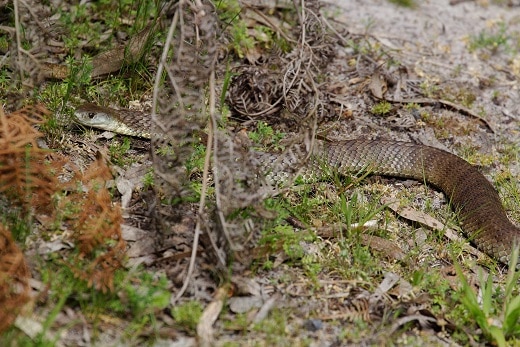
Tiger snakes have multiple confirmed predators, including giant reptiles like southern heath monitors, small-eyed snakes, and a huge cast of birds: goshawks, kookaburras, butcherbirds, kites, and ibises.
The signs suggest that they have a hard life even by snake standards. A study on tiger snakes in Western Australia found that 56% were missing a portion of their tail. 14% had over two thirds missing, and a few had no tail left. Tail breakage is a scientist’s favourite indicator of predator survival in snakes. The tiger snakes with broken tails had a slower maximum speed, achieving less velocity during sudden bursts aimed at escape. But their normal swimming speed wasn’t impaired, and their distance travelled over 5 minutes was identical. Tiger snakes live a brutal life, but have the determination to survive the big, bad Australian countryside.
On the offshore Carnac Island, they lack actual predators, but a study found that 7% of tiger snakes were blind, due to pecking by the nestling gulls they attempted to swallow. These disabled snakes are forced to rely on scent and tongue flecking alone.
| 9 | Identified: the deadliest neurotoxin |
Notexin is one of the confirmed toxins in tiger snakes, which features dual myotoxic and neurotoxic properties. Notexin has similar effects to beta-bungarotoxins, the notorious neurotoxin found in many-banded kraits (Hong Kong). Notexin is a pre-synaptic neurotoxin, preventing the issuing of brain signals (acetylcholine) at the source, the reverse of a black mamba, which prevents acetylcholine from binding. Notexin acts similarly to neurotoxins like taipoxin in coastal taipans, and textilotoxin in eastern brown snakes, so it’s likely that these three evolved from the same source toxin.
Despite this powerful weapon, tiger snake bites are only moderately neurotoxic compared to a black mamba, with symptoms manifesting in just 30% of patients earlier. It’s possible that while potent, the quantity of neurotoxins are too low, being more attuned to small mice and rats.
One of the worst cases involved a 3 year old girl, who suffered respiratory failure and was placed on artificial ventilation for 3 weeks. However, she recovered in the end, following many vials of antivenom. The tiger snake’s neurotoxins act relatively slowly, manifesting within hours, while the procoagulants can take hold within minutes.
| 10 | Moderate muscle mayhem |
In 1998, a study tested the tiger snake’s myotoxic or muscle-assaulting powers, and found the venom to be an intermediate threat. Isolated cells were exposed to raw tiger snake venom, and viewed under a microscope. Firstly, they became strangely spiky or star-shaped. Then they became rounded, and finally, non-adherent and non-viable. Lowland copperheads, mulgas and red-bellied black snakes were strongest, producing damaging morphological changes within 30 minutes, while tiger snakes and death adders produced changes within 1 hour. Coastal taipans were weaker at 2 hours, while only peninsular brown snakes failed to produce any morphological changes.
However, if this 1975 study is any indication, the myotoxins are milder in living, breathing animals. Tiger snake venom was injected into live mice, and there was noticeable myolysis after 12 hours – the destruction of muscle tissue. This time though, surviving myoblasts replicated themselves and formed myotubes, regenerating the lost muscle within 21 days. Adjacent nerve cells are required for muscular regeneration, which surely explains the milder results in living creatures.
The most myotoxic Australian snake is the small-eyed snake, which has a delayed onset of 3-4 days, and is notorious for causing dark urine due to extreme myoglobia. Meanwhile, the survey above found that 11/56 tiger snake victims suffered from myotoxicity. All signs suggest that tiger snakes are moderately damaging to your muscle tissue.